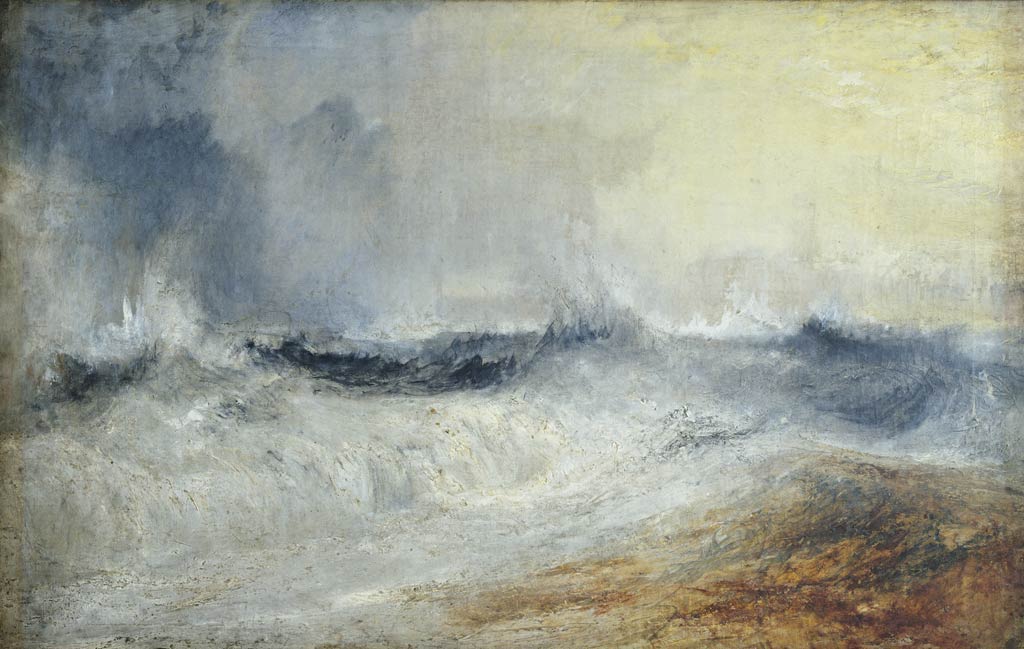Great Works: Waves Breaking Against the Wind c.1835 (58.5cm x 89cm), by J M W Turner
Tate, London

Painting and ageing can be a vexed issue for painter and onlooker alike. Painting through old age can prove to be a trying experience. One of the problems is that when we blithely refer to the late style of, say, a Titian, a Monet, a Poussin or a Picasso, we do not necessarily know whether or not that so-called late style – be it the wholesale reprising of the themes of youth or the looseness of the brush strokes – is at least partially the consequence of physical decrepitude. It is not quite so problematic in the case of Poussin. In some of those late landscapes, we can actually see him trying to do what he could once have done so wonderfully, and being tragically thwarted by the uncontrollable tremor in his hand.
With Monet, matters get a little more complicated. He knew that his sight was failing in the later years of his life, and he spent a long time refusing to be operated upon. Was this a proud, fearful old man's natural cussedness or some belief that whatever was happening to his vision was somehow in line with his imaginative aspirations, and that he could therefore profit by his infirmities? We shall never really know the answer to the question of whether or not Monet's great Nymphéas series in the Orangerie in Paris suffers from being the work of a man who could barely see at all, nor, more generally speaking, how much the perceived success of a late style may or may not depend upon the narrowing intensity induced by cataracts or other eye problems.
We are equally puzzled by many of the later works of Turner. Slightly different questions arise in his case. Many of the works painted during the last decade and a half of his life were left unfinished, and they appeal to our modern sensibility for precisely this reason. We are in love with the provisional, the indefinite, and Turner gives us the indefinite in spades. But finished – or merely abandoned? He was about 60 years of age when he painted the turbulent scene on this page. A recent description of the painting is peppered with such words as perhaps and probably. Perhaps observed at Margate. Can we see Margate's lighthouse and harbour wall in the distance? Perhaps. Perhaps not. Had Turner himself observed the scene from a boat? Yet another, perhaps. There is nothing settled about this scene, and there will be nothing finally settled about its interpretation. Perhaps that is how Turner would have wanted it.
His paintings, time and again, were acts of bravura, showmanship. He would turn up to Varnishing Day at the Royal Academy with canvases underneath his arm that caused complete bemusement. They seemed to show nothing readable by the eye whatsoever. Then, on that last morning, Turner would get to work and over a period of hours he would wrest order from chaos as if by some miracle of the prestidigitator's art. Motifs would be defined, and a few details introduced that would anchor the work in its subject matter. It's a landscape after all!
Turner was not a man for minutiae of detail. You often feel that human beings were too fussy for him to be bothered over, and, it's true, he seldom did them justice. Here the eye strains to anchor itself to a shoreline; outlines of buildings half reveal themselves through the smoky brume. Our wishes for anything more concrete are thwarted. There is no relief from this relentless vision of the sea's untameability. There is no solid ground on which to anchor ourselves. Yes, it is the smoky brume itself, half-muffling all this elemental turbulence, that is as much the subject matter of the painting as anything else. The boiling, roiling sea – it seem to be at war with itself, thrashing back and forth in a frenzy of self-flagellation – is a medley of dramatically different colours. In fact, the extraordinarily sudden and dramatic colour contrasts here, shifting from a steely, muddy white through black to brown, are as startling as anything you would find in Monet, just as the sea itself looks and feels colder, more ferocious and more unruly than many of Monet's seas. And what of this passage of brown in the foreground of the painting? Have our eyes beached, all of a sudden, on a sandbank? There is added violence in the scratchiness of the frenzied brushstrokes, the way they seem to wheel back on each other.
There is such turmoil here, such an onrush and upsuck of air set against the slow burn of a setting sun – if it is indeed a setting sun, and not a kind of moody lapse into an inner vision of an apocalypse. Yes, it could easily be that. You can almost feel Turner seeing his way through these boiling seas to some vision of hell and judgement at least the equal of John Martin, his contemporary.
About the artist: J M W Turner (1775-1851)
The ferociously ambitious English painter J M W Turner was as productive as he was enigmatic. The son of a London barber, his work, with its extraordinarily wide-ranging explorations of light and colour, was mind-boggling in its breadth and audacity. His pictorial imagination soared into realms visited by few others of his or any other generation.
Subscribe to Independent Premium to bookmark this article
Want to bookmark your favourite articles and stories to read or reference later? Start your Independent Premium subscription today.

Join our commenting forum
Join thought-provoking conversations, follow other Independent readers and see their replies